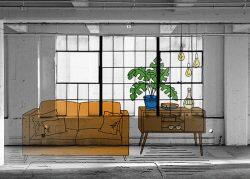Los Angeles is dumping its office desks for sectional sofas.
The nation’s second-largest city has led the nation this year in apartment conversions, setting a record for adaptive reuse of other types of buildings, Rentcafe reported, citing data from sister company Yardi Matrix.
Amid an ever-growing need for housing, adaptive reuse picked up speed in the nation’s largest cities, according to Yardi Matrix, which ranked Los Angeles as the national leader.
L.A. was the No. 1 city with 1,242 unit conversions from January through June; followed by Kissimmee, Florida, with 705; Alexandria, Virginia, with 648; and Honolulu with 500.
Across the nation, some 77,000 units are now being converted out of office, factory, hotel, warehouse, medical, school and religious institutional use, setting up a boom in adaptive reuse. As of July, 8,300 apartments had already been converted and opened to tenants.
Los Angeles also leads in pending conversions, with 4,130 apartments either expected to soon be opened or in the project pipeline, according to Rentcafe. The next largest cities include Cleveland with 2,654 conversions; and Buffalo with 1,984.
In the last two years, apartment conversions across the U.S. jumped by 25 compared to the two years prior.
The increasingly popular real estate niche brought 28,000 new rentals to market in 2020-2021, well above the pre-pandemic years of 2018-2019, when 22,300 apartments were created through adaptive reuse.
Of all possible building conversions, office conversions are at an all-time high, having made way for more than 11,000 apartments nationwide in just the last two years.
The office-to-apartment conversions jumped 43 percent during 2020-2021 at the height of the COVID-19 pandemic, compared to the two years prior, growing from 7,762 to 11,090 apartments.
That compares to 2,700 apartments made from offices in 2010-2011.
Former offices made up 40 percent of all adaptive-reuse conversions to rentals between 2020-2021, the highest share. They were followed by factories at 15.5 percent and hotels at 12.8 percent.
“The residential market needs significantly more density in the areas of the largest cities, where the demand is greatest and where the tallest office buildings are located,” said Doug Ressler, manager of business intelligence at Yardi Matrix. “Existing building architecture is the critical starting point.”
He said larger office buildings in abandoned central business districts were better suited to conversion than the often-smaller office complexes in the suburbs.
The Los Angeles office population hovers at 43 percent of what it was before the pandemic, according to Kastle Systems, which tracks entry card swipes.
Think tank Rand Corp. in Santa Monica identified 2,300 underused office and hotel properties in Los Angeles County that could be converted to housing. Most of them are older office buildings with big chunks of unrented space, according to a March study.
If all the underused buildings were turned into homes it would add up to 113,000 units, Rand said. That’s between 9 percent and 14 percent of the housing needed over the next eight years to meet demand.
Converting an existing building to a new use is more environmentally sustainable than building a new one, but the price of acquiring office buildings can be a barrier to conversion, Rand said.
Although it can cost millions to convert a highrise office to apartments, it’s cheaper than constructing a new building from the ground up. Former office buildings also tend to come with ample parking and other large spaces that can be put to new uses.
– Dana Bartholomew
Read more

